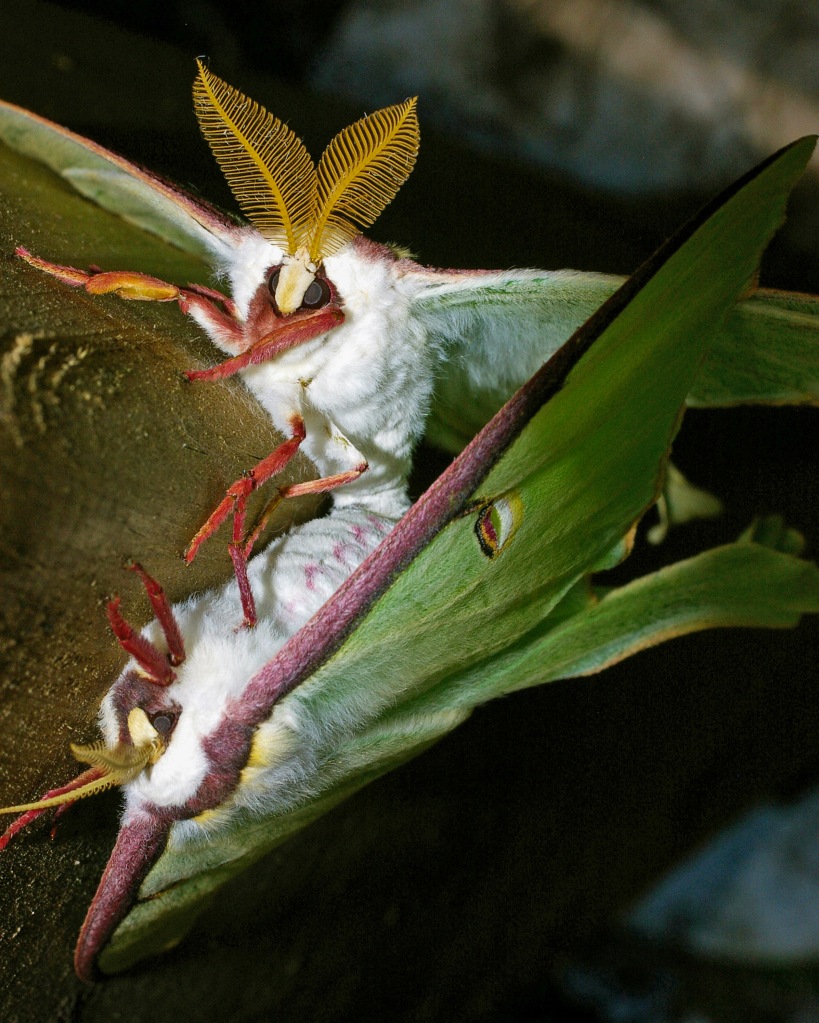Post by Jen Berlinghof
A full moon rises, a screen door slams shut, a katydid’s creaking calls echo, and a Luna moth (Actias luna) flutters in circles around the back porch light. We’re captivated by this green ghost of summer, concealed by broad leaves and seen rarely during the day, emerging at night only to mate for its few fleeting days of adulthood. How lucky it is that Luna moths live in the Lake County Forest Preserves in northern Illinois.

This charismatic insect is in the Saturniidae, or silk moth, family. It boasts a resplendent, three-to-five-inch wingspan adorned with large eyespots that flash and confuse predators. Their wings are also edged in reddish-brown, perfectly mimicking a twig with tiny buds, and they come with twisting tails like streamers to throw off the echolocation of bat predators.
Protective adaptations aren’t limited to the adult stage of the moth’s life cycle. Larvae make clicking sounds with their mandibles as warning signals before regurgitating intestinal contents in an effort to thwart would-be predators. And pupae wriggle and writhe around in their cocoons to avoid becoming lunch.

While the Luna moth makes its home in northern Illinois year-round, it spends the bulk of its time hidden away in a leaf-cloaked cocoon on the forest floor. Two generations of adult moths can be seen in the summer, one from late May to early June and then again from late July to early August. But don’t blink—these adults only live about a week, just long enough to mate and lay eggs. Not even long enough to need a meal, in fact. As adults, Luna moths live off the food they devoured as larvae, and have only vestigial mouthparts and no real digestive system.

In the early morning hours, the thrashing cocoons grow still as the adult Lunas cut their way out of their silken cases using serrated spurs near the base of their wings’ front edge. Once freed, the crumpled creatures spend the remainder of the summer daylight inflating their wings with hemolymph (insect “blood”). When evening arrives, courtship activity follows as females release their perfume, known as pheromones, that males detect with their extra-large, feathery antennae. Males have bigger antennae than females for this purpose, while females sport larger abdomens, needed to carry their 200 to 300 eggs. Mating typically occurs after midnight and may last until dusk the next day.
While females mate only once in their adult life, males can mate each night of their short-lived adulthood. Once mated, a female will deposit her hundreds of eggs in small batches on the undersides of hickory and walnut leaves. Within a week, lime-green larvae speckled with magenta dots parade about, binging on these plants, growing and molting five times before spinning their silken, leafy pupae. The waning light of late summer and early fall signals the pupae to enter a state of suspended development, as they wait out the winter tucked away in cozy camouflage.


Luna moths blend in so well with the leafy landscape that they aren’t usually seen in their natural habitats. Their innate attraction to light—including artificial forms from porch lights to the overhead lights illuminating Little League baseball fields—present the best chance at a glimpse of their pale green majesty. Yet it also offers the moths’ predators the best chance at an easy meal. Scientists speculate that many nighttime flying insects, including Luna moths, use natural light sources from distant stars and the moon to orient their flight. Artificial lights confuse these insects and possibly overload the light receptors in their eyes, disorienting them and resulting in them swarming around outdoor lights. This behavior we witness on summer nights leads to serious risks to these insect populations.

We can help Luna moths and their fellow nocturnal critters by simply turning off exterior lights when possible, or switching to dim, low-voltage, motion-activated, or LED lighting. These are all less attractive to moths and other insects. Perhaps by doing this, we might miss out on the chance to see a Luna up close. We might just have to wait in the dark until the screen door quiets and the katydids pause, and rest assured that there will be a chance to glimpse the silhouette of this green ghost against the backdrop of the full moon.

I love this! Thank you for sharing educational information on this beautiful creature. I was fortunate enough to encounter one in the day this summer and it actually proceeded to stick around for hours. It was located near me in Island Lake in the woods.
Wonderful writing – keep up the good work!